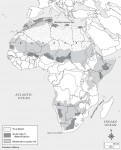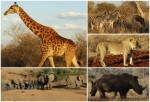
Great Animal Migrations
Any creatures that live in the Kalahari must therefore either survive without relying on easy access to surface water or migrate through the area during the times when the scarce rains fall. Perhaps the most distinctive feature of the Kalahari is the way in which it blends into the larger, surrounding stretch of arid grasslands, […]
Strange Animals Thrive in Harsh Conditions
Many of the most unique and specially adapted creatures of the Arabian Desert have already disappeared or cling to a rootlet of survival. One remarkable creature that has vanished from most of the desert is the ferocious honey badger, a 10-inch-long (250 mm), 25-pound (11 kg) mass of muscle and aggression also known as the […]
Animals Also Evolve Ingenuous Adaptations
The Sahara once had a broad, vital array of animal species, including elephants, lions, ostrich, and a host of other species. But many animals vanished as the climate shifted, the desert expanded, and human beings killed off the fragile survivors. For instance, a hunter killed the last known antelopelike addax in the northern Sahara in […]

Animals, Domestic
Africans have been raising animals for their own use for thousands of years. Species of domesticated animals spread slowly southward through Africa, beginning around 3000 B.C. or earlier, and livestock herding became a traditional way of life across broad regions of the continent. Cattle, in particular, have played a central role in the social, economic, and religious lives of many […]
Redefining Animal Welfare
It is at this point that the conceptualization of animal welfare shifts from a purely instrumentalist notion, here welfare is equated for all intents and purposes with productive efficiency, to a re animalized notion based upon the physical health needs of the individual (including hunger, acute metabolic disease, discomfort, chronic pain, and exhaustion), its mental well being, and its natural behavior. […]
The Difficulty of Animal Welfare
The notion of farm animal welfare is directly linked, first, to the status of farm animals as chattels and commodities, belonging to and traded by farmers and others as a source of revenue and, second, to the fact that their lives, from birth and before, to death, are almost entirely controlled, adapted, and modified by human actors for the purposes of […]
Animal Welfare, Agricultural
Though arguably not a traditional area of geographical concern, agricultural animal welfare is currently attracting the interest of a growing number of human geographers. The (humanist) social sciences in general have long ignored farm animals, and, one might even claim, all animals, rendering them largely invisible and their agency unaccounted for in the analysis of human society. Yet, geography's relatively recent […]
More-than-Human, or Hybrid, Animal Geographies
Other animal geographies have, in recent years, sought to problematize the use of orthodox social categories in their theoretical and empirical approaches to the spatialities of human – nonhuman relations, encounters, and co productions of spaces. This includes ditching many aspects of political economy approaches whilst holding on to a focus on the wider networks in which animals are engaged and […]
Political-Economic Animal Geographies
Animal geographies that have utilized political economic analyses have mainly been found in rural and agricultural geographies. Such studies have at times focused on the development of certain intensive food production regimes as emblematic of current structures of capitalism. For example, studies have focused on chicken and hog intensive production systems in the USA, amongst other matters. Here, animals were always […]
Sociocultural Animal Geographies: Identities and Place
Much of the focus of sociocultural animal geographies has been on animal roles in construction and ordering of culture and individual human subjects, and wider links between human and animal identities in particular times and places. Some animal geographies have experimentally approached animals as something akin to a marginal social group that emphasizes unequal power relations between animals and people, and […]
New Animal Geographies
Many of the renewed animal geographies that emerged in the mid 1990s sought to put some distance between themselves and cultural ecology and Sauer's cultural geography, though some writers do point to a few continuities with that tradition. Such work emerged out of the new cultural geographies that took more materialist approaches to cultural interactions, post structuralist theories that decentered human […]
Early Cultural Geographies of Animals
In contrast to zoogeographical work, early twentieth century geographies of animals sought to examine how some animal distributions were affected by human groups through animal domestication and introductions of animals into new regions. Studies of animal domestication were rejuvenated by evolutionary theory in the late nineteenth and twentieth centuries – viewing animal domestication as one of the main qualities and practices that […]
Histories of Animal Geographies
Animals have long had a presence in geography as a discipline. In the modern period, two closely related approaches characterized a distinct study of animals in geography. The first became known as zoogeography and sought to map evolutionary distributions of animals and was closely allied to what was to become a more physical geographical approach, allied with zoology and the (then) emerging […]
Animal Geographies
Animal geographies might, at first, be thought a misnomer by those coming across the term for the first time. Current geographies of animals are not just about animals; how could they be? Instead, current animal geographies seek to challenge entrenched assumptions about animals in modern societies and in the historical developments of humanities disciplines. Recent animal geographies have […]